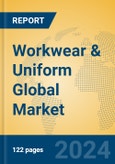Introduction
Workwear and uniforms are specialized apparel designed for professional use across industries like healthcare, manufacturing, hospitality, and security, prioritizing safety, durability, and brand identity. The market is driven by global employment growth, with 53 million new jobs projected by 2025, per the International Labour Organization, and increasing demand for functional, stylish uniforms. The market spans protective clothing, corporate attire, and industry-specific garments, with trends focusing on sustainability, ergonomic designs, and smart textiles. Key players like VF Corporation and Cintas lead through scale, while niche firms like Engelbert Strauss cater to regional needs. The market benefits from rising workplace safety regulations and corporate branding but faces challenges from counterfeit products, high production costs, and shifting consumer preferences. Asia Pacific, with 56 million jobs tied to U.S. consumer spending, is a key growth region due to its manufacturing base and trade vulnerabilities.Market Size and Growth Forecast
The global Workwear & Uniform market is projected to reach a market size of 70-80 billion USD by 2025, with an estimated compound annual growth rate (CAGR) of 4%-6% through 2030. Growth is driven by workplace safety standards, branding needs, and emerging market demand.Regional Analysis
- North America is expected to grow at 3.5%-5.5%, led by the United States and Canada. The U.S. drives demand through its large healthcare and construction sectors, with Canada’s 17.1% job dependency on U.S. spending fueling uniform needs, though high costs limit growth.
Asia Pacific is anticipated to grow at 4.5%-6.5%, led by China, India, and Japan. China’s manufacturing dominance and workplace safety regulations drive demand, while India’s construction and healthcare sectors fuel growth. Japan’s aging workforce supports demand for ergonomic workwear, though cost sensitivity limits pace.
- South America, with a growth rate of 3%-5%, sees Brazil and Mexico as key players. Brazil’s industrial and healthcare sectors drive demand, while Mexico’s trade ties with the U.S. fuel growth, tempered by economic volatility.
- The Middle East and Africa are projected to grow at 3%-5%, with the UAE and South Africa leading. The UAE’s hospitality and security sectors drive uniform demand, while South Africa’s mining industry supports growth, constrained by economic challenges.
Application Analysis
- Luxury Retail: Expected to grow at 3%-5%, driven by branding needs. Trends focus on stylish, premium uniforms to enhance customer experience.
- Sports: Projected to grow at 4%-6%, fueled by team and event uniforms. Trends emphasize performance fabrics and sustainability.
- Health and Beauty: With a growth rate of 3.5%-5.5%, this segment focuses on hygienic, comfortable uniforms. Trends include antimicrobial fabrics.
- Pharmaceutical: Expected to grow at 3%-5%, driven by cleanroom requirements. Trends focus on compliance with stringent regulations.
- Engineering and Manufacturing: Projected to grow at 4%-6%, fueled by safety standards. Trends emphasize flame-resistant and durable materials.
- Property Management: With a growth rate of 3%-5%, this segment prioritizes professional attire. Trends focus on ergonomic designs.
- Hospitals: Expected to grow at 4%-6%, driven by healthcare expansion. Trends include infection-resistant fabrics.
- Security: Projected to grow at 3.5%-5.5%, fueled by safety needs. Trends emphasize tactical and durable uniforms.
- Transportation: With a growth rate of 3%-5%, this segment focuses on visibility and comfort. Trends include reflective materials.
- Others: Expected to grow at 3%-5%, including niche applications like education, with trends focusing on customization.
Key Market Players
- Carhartt: A U.S. leader, Carhartt offers durable workwear for construction and manufacturing, focusing on rugged designs.
- VF Corporation: A U.S. giant, VF provides workwear brands like Dickies, emphasizing safety and style.
- Alsico: A Belgian firm, Alsico delivers uniforms for healthcare and hospitality, prioritizing sustainability.
- Barebones Workwear: A U.S. company, Barebones offers affordable workwear for SMEs, focusing on durability.
- Cintas Corporation: A U.S. leader, Cintas provides uniform rental services, emphasizing customization.
- Williamson-Dickie: A U.S. firm, Williamson-Dickie offers workwear for industrial sectors, focusing on functionality.
- Aramark: A U.S. company, Aramark delivers uniform services for hospitality and healthcare, prioritizing efficiency.
- Engelbert Strauss: A German firm, Engelbert Strauss provides premium workwear for European markets, focusing on ergonomics.
Porter’s Five Forces Analysis
- Threat of New Entrants: Moderate. Low technical barriers allow entry, but brand loyalty and economies of scale favor established players like Cintas.
- Threat of Substitutes: Low. Generic clothing is an alternative, but regulatory and branding requirements limit substitution risks.
- Bargaining Power of Buyers: High. Large clients like hospitals wield influence due to bulk orders, though customization reduces switching options.
- Bargaining Power of Suppliers: Moderate. Textile suppliers hold some leverage, but diversified sourcing and vertical integration by firms like VF mitigate power.
- Competitive Rivalry: High. Intense competition among VF, Cintas, and regional players drives innovation in sustainability and smart textiles.
Market Opportunities and Challenges
Opportunities- Global Employment Growth: 53 million new jobs by 2025 create demand for uniforms, particularly in healthcare and manufacturing in Asia Pacific.
- Sustainability Trends: Demand for eco-friendly fabrics offers opportunities for recycled and biodegradable workwear, especially in Europe.
- Smart Textiles: Innovations in wearable technology, like temperature-regulating fabrics, create potential for high-value applications globally.
- Emerging Markets: Expanding industrial and service sectors in India and South America drive demand for affordable workwear.
- Corporate Branding: Growing emphasis on brand identity supports demand for customized uniforms in retail and hospitality.
- Counterfeit Products: Fake workwear undermines brand reputation and safety compliance, particularly in Asia Pacific.
- High Production Costs: Rising raw material and labor costs pressure margins, challenging competitiveness in price-sensitive markets.
- Regulatory Compliance: Stringent safety standards in Europe and North America increase production costs, impacting smaller players.
- Trade Tensions: Global trade risks, affecting 84 million jobs, create supply chain disruptions, particularly in Asia Pacific.
- Shifting Preferences: Rapid changes in fashion and functionality require constant innovation, pressuring manufacturers.
This product will be delivered within 1-3 business days.
Table of Contents
Companies Mentioned
- Carhartt
- VF Corporation
- Alsico
- Barebones Workwear
- Cintas Corporation
- Williamson-Dickie
- Aramark
- Engelbert Strauss
- Fristads
- VP Capital
- Hejco Yrkesklader
- Johnson Service Group
- JAAG Enterprises LTD.








